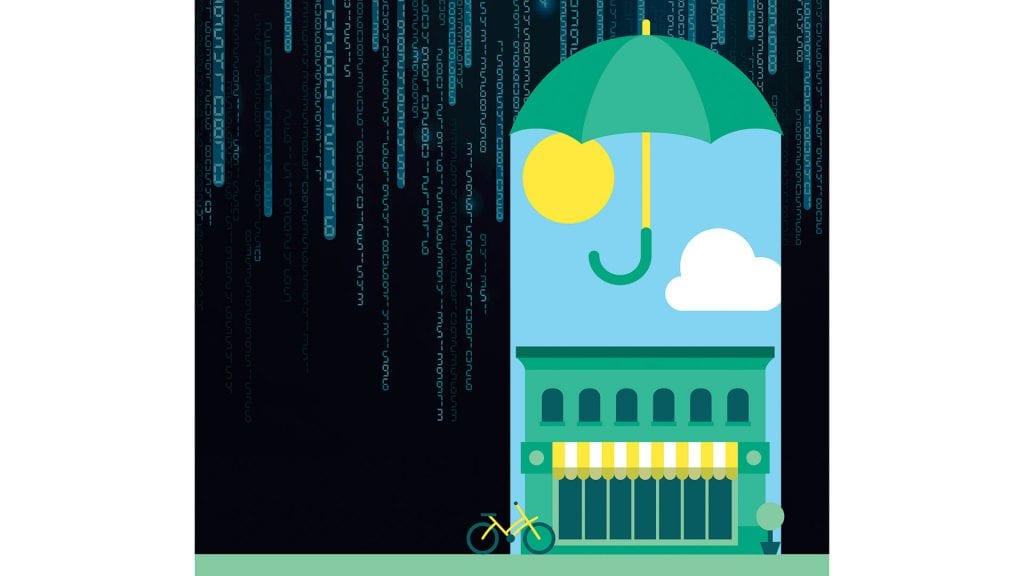Strong Signals
By Mark Morris

When the pandemic arrived early last year and many companies adjusted to remote work for their staff, it was IT professionals who got everyone up and running from their homes.
Now, as the world begins to move away from the pandemic and companies begin bringing employees back to the office, the demand to hire IT pros is even higher than it was before COVID-19 emerged. And that poses challenges for employers.
In a normal year, said Delcie Bean, CEO of Paragus Strategic IT, the company sees about 10% turnover of people leaving and new staff being hired. During the pandemic, there was no turnover, as every one of the 50 Paragus employees stayed in their job.
In the last four months, however, as the economy has improved and COVID restrictions have eased, Bean has seen a “tremendous transition” among the IT labor force.
“Many of those who are leaving are pursuing remote-work opportunities that didn’t exist before the pandemic,” he said. “Most of these companies are not local and would never have interviewed or offered jobs to these workers in the past.”
Bean cited a number of reasons for the high demand for IT talent. During the pandemic, nearly every company increased their use and dependence on technology, which requires more people to keep systems up and running. As the economy improves, companies are pursuing more projects and thus increasing their need for IT talent. The pandemic also made it acceptable to hire people who work only remotely, creating even more opportunities for IT pros.
“With the increased dependence on technology, an improved economy, and the ability to work remotely, we’re seeing employers do things they would not have done before,” he said.
Joel Mollison, president of Northeast IT Systems, noted that, unlike others in IT support, his 18-person company does not have high worker turnover. He credits that to attracting IT staff who enjoy working with Northeast’s varied client list, which covers sectors from insurance and healthcare to manufacturing, municipalities, and even cannabis.
“Many of those who are leaving are pursuing remote-work opportunities that didn’t exist before the pandemic. Most of these companies are not local and would never have interviewed or offered jobs to these workers in the past.”
One notable challenge to retaining his workforce involves companies such as banks, manufacturers, and other industries that are looking to bring their IT support in-house, he said. “As a service provider in Western Mass., we’re competing against much larger institutions in the region who can pay IT professionals more.”
As security issues receive prominent news coverage, companies worry more about ransomware attacks and similar threats. Mollison believes this is part of the reason firms are increasingly looking for in-house IT staff.
“The larger the business, the more complex their systems are, and the more they need IT professionals to manage them,” he explained.
Bean agreed that IT security issues have increased the pressure for companies to be proactive in preventing major disruptions, pointing out that much of the job growth is the result of companies expanding their internal IT staff both regionally and on a national level.

Delcie Bean says an IT workforce that was remarkably stable in 2020 has entered a time of “tremendous transition.”
“All these companies are doing this because the growing economy gives them a little more money and it can be a luxury to have your IT support in-house.”
Jeremiah Beaudry, owner of Bloo Solutions, agrees, but believes that, after companies build up their internal IT staffing, they usually return to outsourcing with an external service provider once they realize that internal IT is less cost-effective.
“Instead of paying full-time employees to show up every day, companies can hire an IT firm that knows all the technical details and address specific problems when they arise,” Beaudry said. “It would be similar to bringing a plumber on staff. Why would you do that?”
In fact, he predicts that the hiring surge for internal IT will shake out to one or two positions to oversee the main systems augmented by an outside IT service provider.
Bean said it’s common for companies to have an internal person handling technology issues as well as an outside IT service company. “Our biggest source of new business right now involves partnering with internal IT departments to round out what they are doing and give them supplemental assistance.”
Here and There
Like many industries right now, technology is grappling with a job market that significantly favors job seekers. Bean told the story of an employee who had previously worked in the defense-contracting industry 10 years ago.
“Because this employee’s name was still in the defense system, a contractor called him to make a job offer, sight unseen and without an interview,” he said. “They literally e-mailed him an electronic salary offer without meeting him, and it was for $35,000 more than he was making here.”
A company located in a large metro area interested in hiring remote workers will offer salaries that are competitive in their market. This can often lead to small-market workers getting big-city paydays.
“If you’re at home and take five minutes between tasks to turn around to pet your dog or do the dishes real quick, that time becomes meaningful and helpful in your life.”
“Usually, when someone makes a salary that’s attractive in Boston, it comes with the high cost of living in the metro Boston area,” Bean said. “When someone with a Western Mass. cost of living makes that same amount, they can see a 30% net increase in their salary.”
Indeed, more companies than ever are embracing remote or hybrid workforces (see related story on page 25). That means IT service providers face the same dilemma confronting many of their clients: continue to work from home or go back to the office.
Mollison tells a slightly different story. Before COVID, he said, Northeast IT was outgrowing its space in Westfield, so he suggested that staff work remotely as a short-term solution. He was surprised when almost no one wanted to work from home.
“Nearly everyone wanted to work in the office,” he recalled. “We have a kind of think-tank environment where our staff enjoy working on problems together.”
However, the pandemic forced nearly everyone to work from home for the last 16 months, a situation Mollison called stressful because many felt less connected to their co-workers. He added that a change in venue is coming. “We purchased a building in West Springfield and will be moving in at the end of August. We’ll have plenty of space to bring everyone back with social distancing; our people are really looking forward to returning.”
At Paragus, employees have been ramping up their return to the office by coming in one day a week in June, two days a week in July, and three days a week starting in August. Bean said he won’t require more than three days a week in the office, but felt that some time in the office was important.
“We have intentionally designed our office to promote collaboration,” he said. “We don’t have walls or offices, so people can listen to each other and overhear what’s going on. You can replicate some of that online, but it’s not the same as hearing what’s going on around you.”
At Bloo Solutions, Beaudry has allowed his four full-time and several part-time employees to stay remote except for occasional trips to the office or when visiting a client’s location. Collaborative messaging tools like Slack and Microsoft Teams allow him and his staff to stay in touch with each other and stay on top of client concerns.

Jeremiah Beaudry says even companies that have built up internal IT staffing often come to see the value in outsourcing that work.
“We have channels dedicated to each client so any one of us can jump in and take care of any concerns,” he said. “Because we all have access to these messages, the same information is available to all of us without being next to each other.”
Whenever possible, Beaudry makes working from home an option for his staff.
“If you’re at home and take five minutes between tasks to turn around to pet your dog or do the dishes real quick, that time becomes meaningful and helpful in your life,” he said. “When you are in the office and not near anything you need to do, that same five minutes is wasted.”
Therefore, as long as his staff are productive, he doesn’t care if they work from home or at the office.
Another reason Bean cited for having people in the office at least some of the time is to help with their professional development and to identify when a staff member might need help. He worries that IT professionals who have chosen full-time remote work won’t have the same chance to grow or develop their careers.
“They will probably be fine doing the job they were hired for, but they will be relatively unengaged and potentially stagnant,” he said. “I don’t see how they can grow or develop much in an environment where they never see their co-workers or be around other people.”
Mollison credits his low staff turnover to seeking out people who like variety in their work and have an interest in personal and professional growth.
“Because IT folks tend to be introverts, we try to help them grow personally so they can become more comfortable working with clients and developing relationships with them,” he said.
While finding people in Western Mass. with technical skills isn’t so tough, Beaudry makes his hiring decisions based on a candidate’s emotional intelligence.
“I’ve learned over time that clients would rather feel good about a conversation they had rather than having an expert solve the problem who makes them feel bad about themselves,” he said.
Change Can Be Good
Another reason the demand for IT professionals is increasing has to do with the growing economy. Bean said the sales pipeline for new projects has never been fuller. “In terms of new business, we’re booking clients out to October because we only book so much at a time.”
In addition to hiring temporary contract workers, he has found another way to make up worker shortages: acquisitions. Paragus recently acquired one IT-support company in Worcester and is looking at two other acquisitions.
“In the past, the goal of an acquisition was to acquire clients and market,” he said. “Now it’s about acquiring talent.”
Would Bean like to see less disruption in the labor force? Sure. He also understands that this time of transition is part of the bigger picture.
“Everybody is moving around, so we’re on the receiving end of this as well,” he told BusinessWest. “The good news is we haven’t seen a shortage of any new résumés coming in.”
While it’s tempting to dwell on the employees leaving, however, Bean has gained some perspective.
“After some reflection,” he said, “we realized that a lot of the innovation and fresh approaches we get are driven by new people coming in with new ideas.”





 The recent spate of high-profile cyberattacks, many involving paid ransoms featuring six or seven zeroes, has brought an ongoing, and escalating, problem even more to the forefront. Businesses are being advised that the problem needs to be managed — before the worst happens. That means having a detailed plan involving many layers to keep things safe.
The recent spate of high-profile cyberattacks, many involving paid ransoms featuring six or seven zeroes, has brought an ongoing, and escalating, problem even more to the forefront. Businesses are being advised that the problem needs to be managed — before the worst happens. That means having a detailed plan involving many layers to keep things safe.










